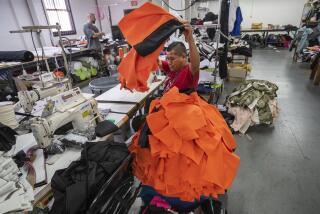May Inventories Up 0.7%; Biggest Rise in 3 Years
- Share via
WASHINGTON — Business inventories soared 0.7% in May as a backlog of unsold cars and a slump in sales of furniture and appliances contributed to the biggest rise in inventories in more than three years, the Commerce Department said Wednesday.
The department reported that inventories on shelves and in back lots climbed to a record high of $670.4 billion in May following a 0.4% rise in April.
The 0.7% increase was the largest month-to-month gain since a 1.2% advance in February, 1984.
The report said that the big rise in inventories was accompanied by a weak 0.2% increase in business sales during May, which rose to a seasonally adjusted $445.2 billion following a 0.2% decline in April.
Analysts attributed much of the inventory increase to a continued buildup of unsold cars. They noted that inventories of cars on dealer lots rose 1% in May compared to April and now stand almost 10% higher than they were a year ago.
“Once again we have the recession in the auto industry showing up in unwanted accumulation in autos,” said Allen Sinai of Shearson Lehman Bros. in New York. “It will add to the gross national product in the second quarter, but that weakness eventually will have to be reversed.”
Housing Slump Cited
In addition to the buildup of unsold cars, inventories at furniture, home furnishing and appliance stores climbed 1.5% in May.
Michael Evans, head of a Washington forecasting firm, said this increase reflected a decline in home sales during spring because of the sharp run-up in mortgage interest rates in April and May.
Evans said the combination of rising inventories at a time of sluggish sales would translate into a weak economy during the second half of the year as businesses slash production to work down unwanted inventories.
But Robert Ortner, Commerce under secretary for economic affairs, said the May increase in inventories was not troublesome because businesses have been successful during this recovery in making sure that inventory levels did not get out of line with sales.
The 0.7% increase in inventories was led by a 1.8% jump in inventories at the wholesale level. Inventories held by retailers rose 0.5% while inventories at the manufacturing level were up 0.2%.
Sales at the wholesale level rose 0.7% while sales by manufacturers were up 0.2%. These gains offset a 0.3% drop in sales at the retail level in May. The government said Tuesday that retail sales in June rebounded slightly, rising by 0.4%.
The combination of a big rise in inventories and a sluggish increase in sales left the inventory-to-sales ratio at 1.51 in May compared to 1.50 in April. That means it would take 1.51 months to exhaust total inventories at the May sales pace.
In another economic report, the Federal Reserve reported that production at the nation’s factories, mines and utilities edged up a slight 0.2% in June as strength in non-manufacturing helped offset a big drop in auto production.
The Federal Reserve said the June production increase followed a much stronger 0.5% rise in output during May. It was the weakest performance since production showed no increase at all in April.
More to Read
Inside the business of entertainment
The Wide Shot brings you news, analysis and insights on everything from streaming wars to production — and what it all means for the future.
You may occasionally receive promotional content from the Los Angeles Times.










